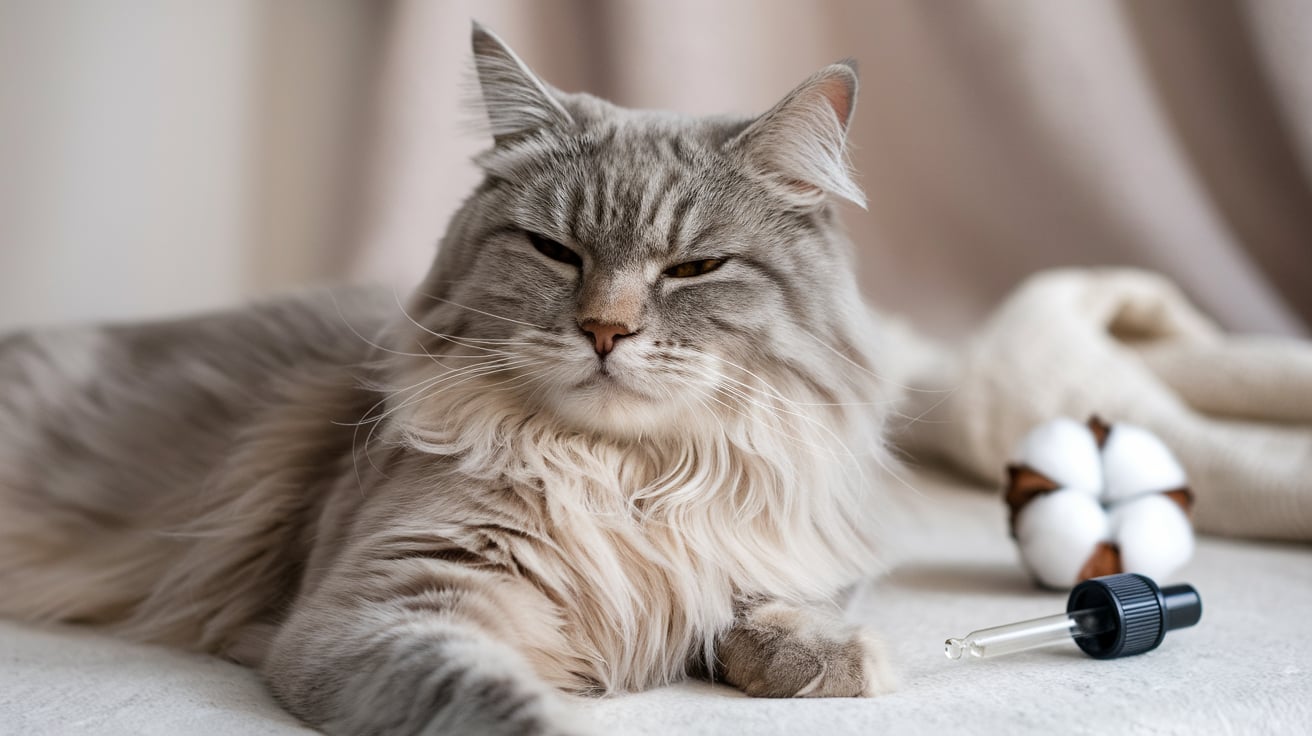Cats often develop ear mites, which can irritate and cause ear discomfort. These tiny parasites, scientifically known as Otodectes cynotis, live in the ear canal, feeding on wax and oils. If left untreated, ear mites can lead to serious infections and damage to the ear. Early signs often include frequent head shaking, excessive scratching of the ears, and the presence of dark, crumbly discharge resembling coffee grounds.
Treating ear mites at home can be a practical option, especially in mild cases. With proper care, you can relieve your cat’s discomfort and stop the mites from spreading to other pets in your household. However, it’s important to recognize when a home remedy might not be enough. In severe cases, consulting a veterinarian is essential to ensure your cat receives the right treatment and to rule out other ear-related conditions. By combining home care with professional guidance when needed, you can protect your cat’s health and comfort.
Benefits of Using Home Remedies
Treating ear mites in cats with home remedies offers a gentle and natural approach, which can be especially beneficial for sensitive pets. Many home remedies use ingredients like olive oil, coconut oil, or apple cider vinegar, which are not only effective in soothing irritation but also free of harsh chemicals. These remedies can reduce inflammation, help dislodge mites, and keep your cat comfortable throughout the healing process.
Home remedies are also highly cost-effective and easy to implement. Most of the ingredients are commonly found in households, eliminating the need for expensive treatments or multiple vet visits for mild cases. This accessibility makes them an appealing option for cat owners who want to provide quick relief without breaking the bank.
Another key advantage is the reduction in unnecessary chemical exposure. Some over-the-counter treatments for ear mites contain potent pesticides, which may not always be suitable for all cats, particularly kittens or those with allergies. By using natural methods, you minimize the risk of side effects while addressing the problem effectively and safely.
Effective Home Remedy for Ear Mites in Cats
Home remedies can effectively relieve cats suffering from ear mites, as long as they are applied carefully and appropriately.
Coconut Oil
Coconut oil is renowned for its soothing properties and ability to smother mites, effectively cutting off their oxygen supply. The oil’s natural anti-inflammatory properties help calm irritated skin, providing instant relief to your cat.

How to Apply:
- Warm a teaspoon of coconut oil until it’s liquid but not hot.
- Use a clean dropper to place 2–3 drops into your cat’s ear canal.
- Gently massage the base of the ear to spread the oil.
- Any extra oil surrounding the ear can be cleaned with a cotton ball.
- For almost a week, repeat this procedure once every day.
Olive Oil
Olive oil works well to clean and lubricate the ear canal, helping to remove wax and debris where mites thrive. It’s a simple yet effective remedy to make the ear environment less hospitable to parasites.

How to Use Safely:
- Slightly warm the olive oil.
- Administer 3–4 drops into your cat’s ear using a dropper.
- Massage the ear gently to loosen debris.
- Wipe the ear canal’s outer area with a soft cotton pad.
This method can be repeated every 2–3 days until symptoms improve.
Apple Cider Vinegar Solution
Apple cider vinegar has antibacterial and antifungal properties, making it an excellent choice for preventing secondary infections. When diluted correctly, it can also help create an environment that is hostile to ear mites.
Dilution and Use:
- Combine water and apple cider vinegar in equal amounts.
- Dip a cotton ball into the solution and gently clean the outer ear area.
- Avoid letting the solution drip deep into the ear canal.
For a week, use this cure once a day.
Aloe Vera Gel
Ear mite-induced inflammation and irritation can be effectively reduced with aloe vera gel. Its natural cooling effect provides comfort to cats with sensitive ears.
Application Guide:
- Use fresh, pure aloe vera gel or a product without additives.
- Apply a small amount to the ear’s outer edges using your fingers or a cotton swab.
- Avoid deep insertion into the ear canal.
Repeat as needed to ease irritation.
Tea Tree Oil (Use with Caution)
Tea tree oil has strong anti-parasitic properties but must be used cautiously due to its potential toxicity to cats. Heavy dilution is critical for safe application.
Safety Tips:
- Mix 1 drop of tea tree oil with 1 tablespoon of carrier oil like olive oil or coconut oil.
- Apply 1–2 drops of the diluted mixture to the outer ear using a cotton swab.
- Do not let your cat lick or ingest the oil.
Limit use to once every 3–4 days and monitor for any adverse reactions.
By carefully selecting and using these remedies, you can manage your cat’s ear mites effectively while ensuring their comfort and safety.
Step-by-Step Guide to Applying Home Remedies
Successfully treating ear mites at home requires a calm approach and attention to detail. Follow these steps to ensure your cat is comfortable and the remedies are applied effectively.
1. Prepare Your Cat
Before beginning, create a calm and quiet environment to keep your cat relaxed. Gently wrap them in a soft towel, leaving their head exposed to prevent sudden movements. Speak soothingly and use gentle strokes to reassure them. Having a helper to hold your cat can also make the process easier.
2. Clean the Ears
Proper cleaning is essential to remove debris and wax where mites thrive. Use a clean, damp cotton ball or a soft cloth to wipe the outer ear gently. Cotton swabs can push particles deeper into the ear canal, so avoid using them. Cleaning prepares the ear for the remedy and ensures it reaches the affected area effectively.
3. Apply the Remedy
The method of application will depend on the remedy you’re using:
- Coconut or Olive Oil: Warm the oil slightly and use a clean dropper to place 2–3 drops into the ear canal. To disperse the oil, gently massage the base of the ear.
- Apple Cider Vinegar Solution: Dip a cotton ball into the diluted solution and wipe the outer ear area carefully.
- Aloe Vera Gel: Apply a small amount to the outer ear edges with your fingers or a cotton swab.
- Tea Tree Oil Mixture: Using a highly diluted mixture, apply a few drops to the ear edges, ensuring no ingestion occurs.
4. Repeat and Monitor
Most remedies should be applied once daily or as instructed, depending on the severity of the infestation. Continue the treatment for 7–10 days or until symptoms improve. Monitor your cat closely for signs of progress, such as reduced scratching, less head shaking, and improved ear cleanliness.
If symptoms persist or worsen, consult a veterinarian promptly to rule out underlying issues or secondary infections. Patience and consistency are key to ensuring your cat recovers quickly and comfortably.
Conclusion
Home remedies for ear mites in cats, such as coconut oil, olive oil, apple cider vinegar, aloe vera gel, and tea tree oil (with caution), can provide effective relief when applied correctly. These remedies not only help eliminate mites but also soothe irritation and prevent further discomfort. Each remedy offers unique benefits, from smothering mites to reducing inflammation and keeping the ears clean.
However, while these treatments can be highly effective for mild cases, it’s important to consult a veterinarian if symptoms persist, worsen, or if your cat shows signs of a more severe infection. A vet can ensure proper diagnosis and recommend additional treatments if needed.
Consistency in care is crucial to preventing future infestations. Regularly checking and cleaning your cat’s ears can help catch any issues early, keeping them healthy and comfortable. By combining attentive home care with professional advice when necessary, you can ensure your cat’s ears remain mite-free and their well-being is prioritized.
FAQs
How can cats develop ear mites, and what are they?
Ear mites are microscopic parasites that reside in cats’ ear canals and consume wax and oils for food. They are highly contagious and can spread from one animal to another through direct contact or shared bedding. Outdoor cats or those in multi-pet households are more susceptible.
What are the first signs of ear mites in cats?
Common signs include excessive scratching at the ears, frequent head shaking, and the presence of dark, crumbly ear discharge that resembles coffee grounds. Cats may also show irritation or discomfort when their ears are touched.
Are home remedies safe for treating ear mites?
Home remedies are generally safe when used properly. Natural options like coconut oil, olive oil, or aloe vera gel are non-toxic and effective for mild cases. However, because pure tea tree oil can be dangerous to cats, therapies like it need to be greatly diluted.
How often should I apply home remedies?
Most remedies should be applied once daily for about 7–10 days. Consistency is key to ensuring mites are fully eliminated. Always monitor your cat for signs of improvement or adverse reactions.
When should I consult a veterinarian?
Consult a vet if your cat’s symptoms persist after a week of treatment, if the infestation appears severe, or if your cat shows additional signs like swelling, redness, or a foul odor from the ears. These could indicate a secondary infection that requires professional care.
How can I prevent ear mites from coming back?
Check and clean your cat’s ears regularly to maintain hygiene. If you have multiple pets, treat all animals simultaneously to prevent re-infestation. Keeping your cat’s environment clean and avoiding contact with infested animals can reduce the risk.
Can humans get ear mites from cats?
While rare, ear mites can occasionally transfer to humans, causing minor skin irritation. However, they cannot thrive in the human ear. Proper treatment of your cat and maintaining cleanliness will minimize any risk of transmission.
